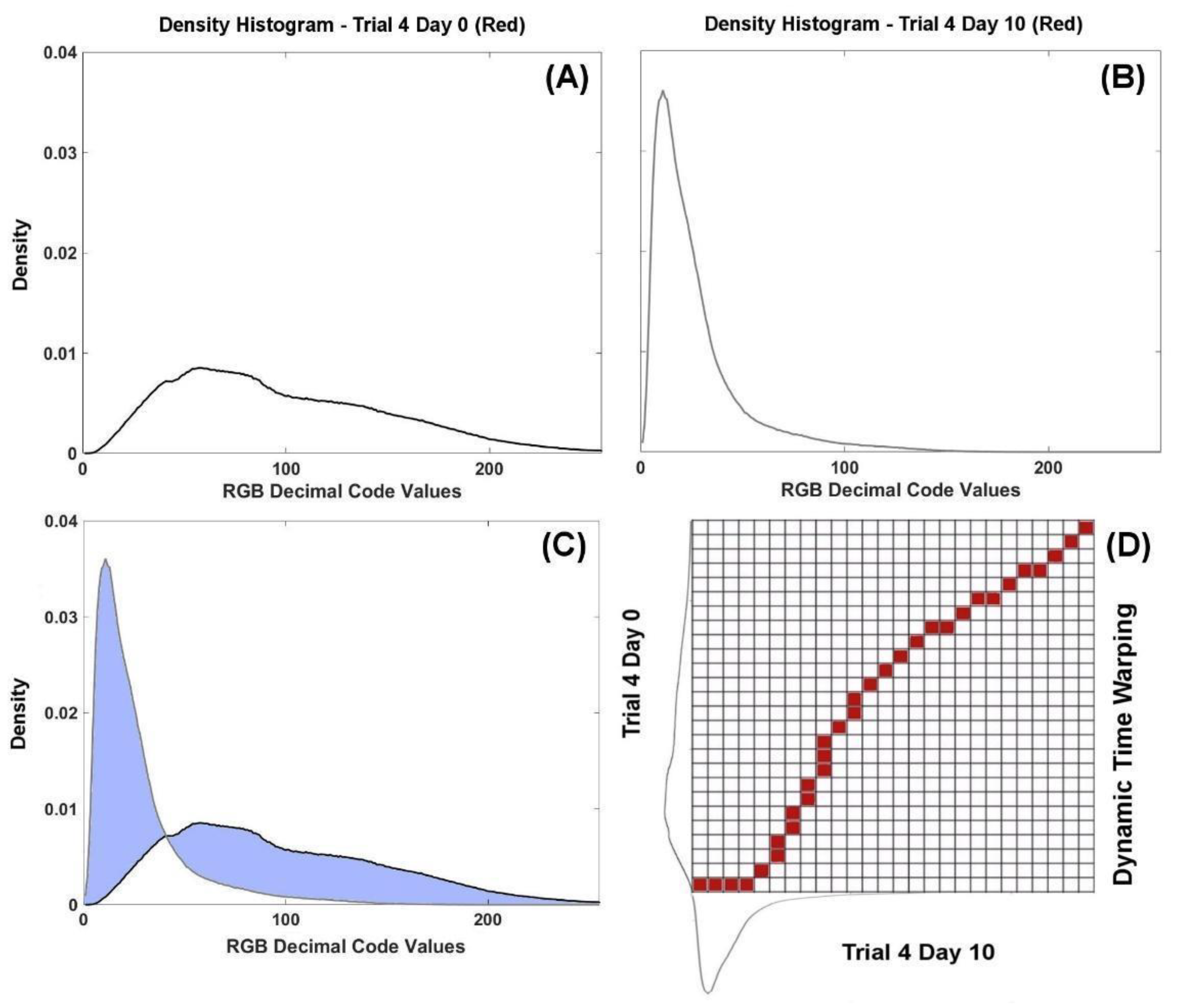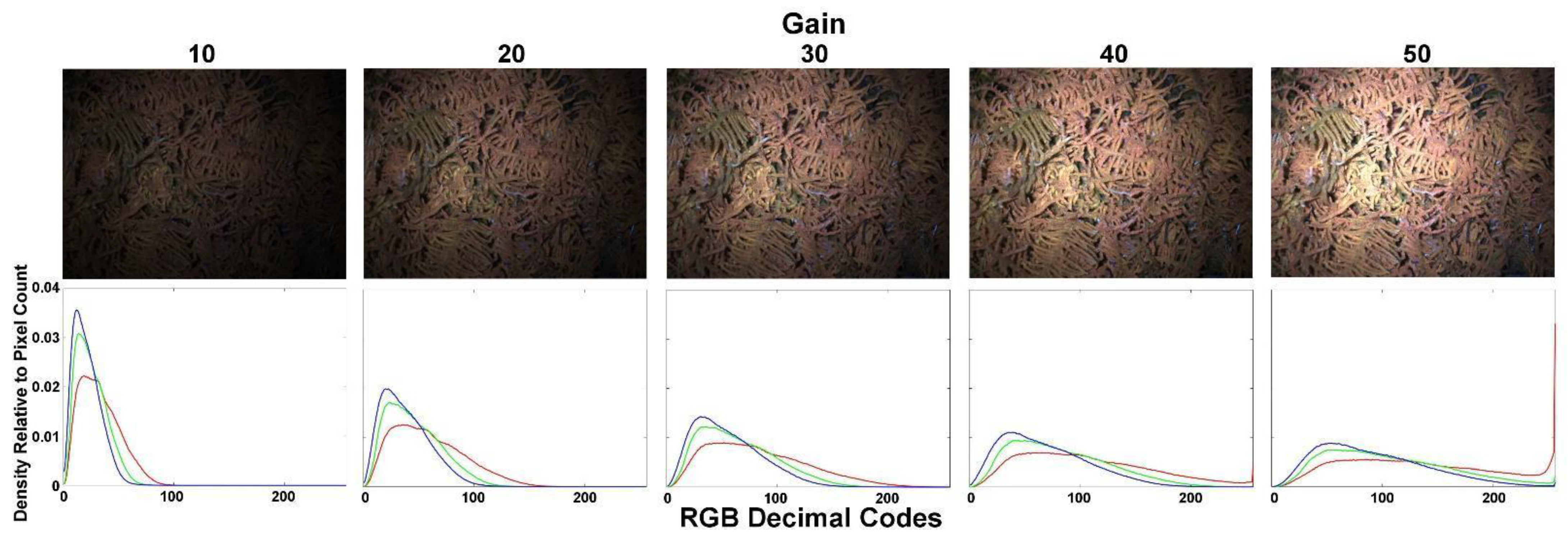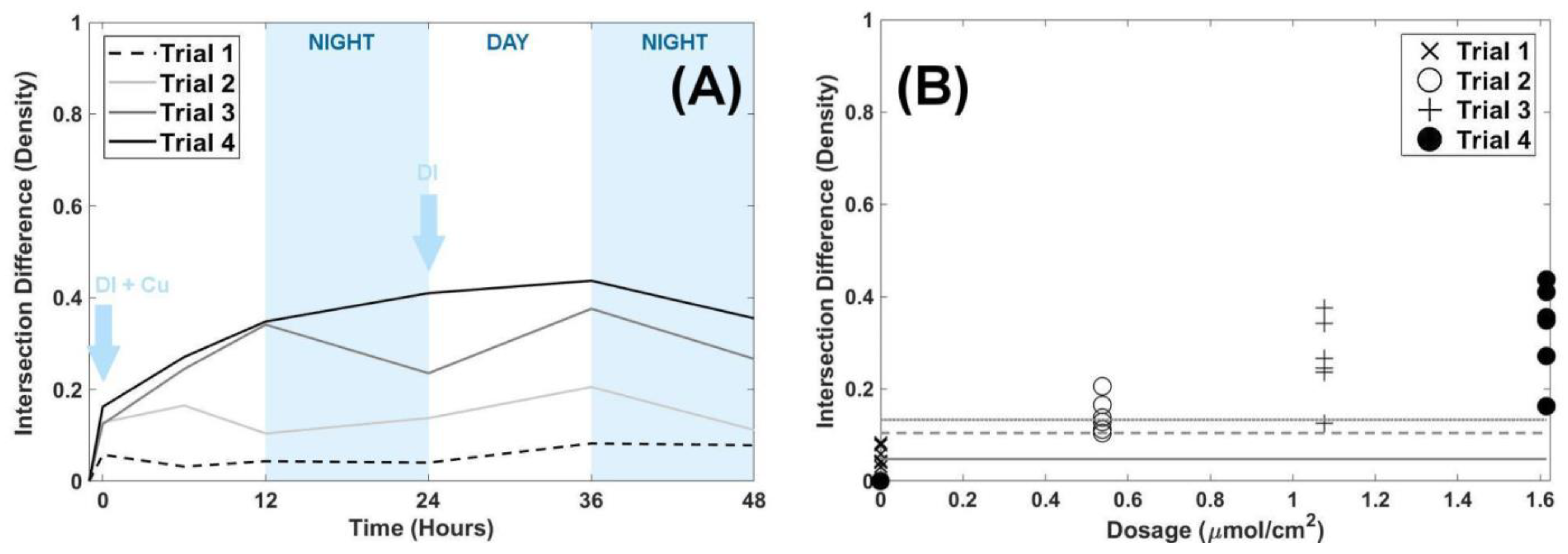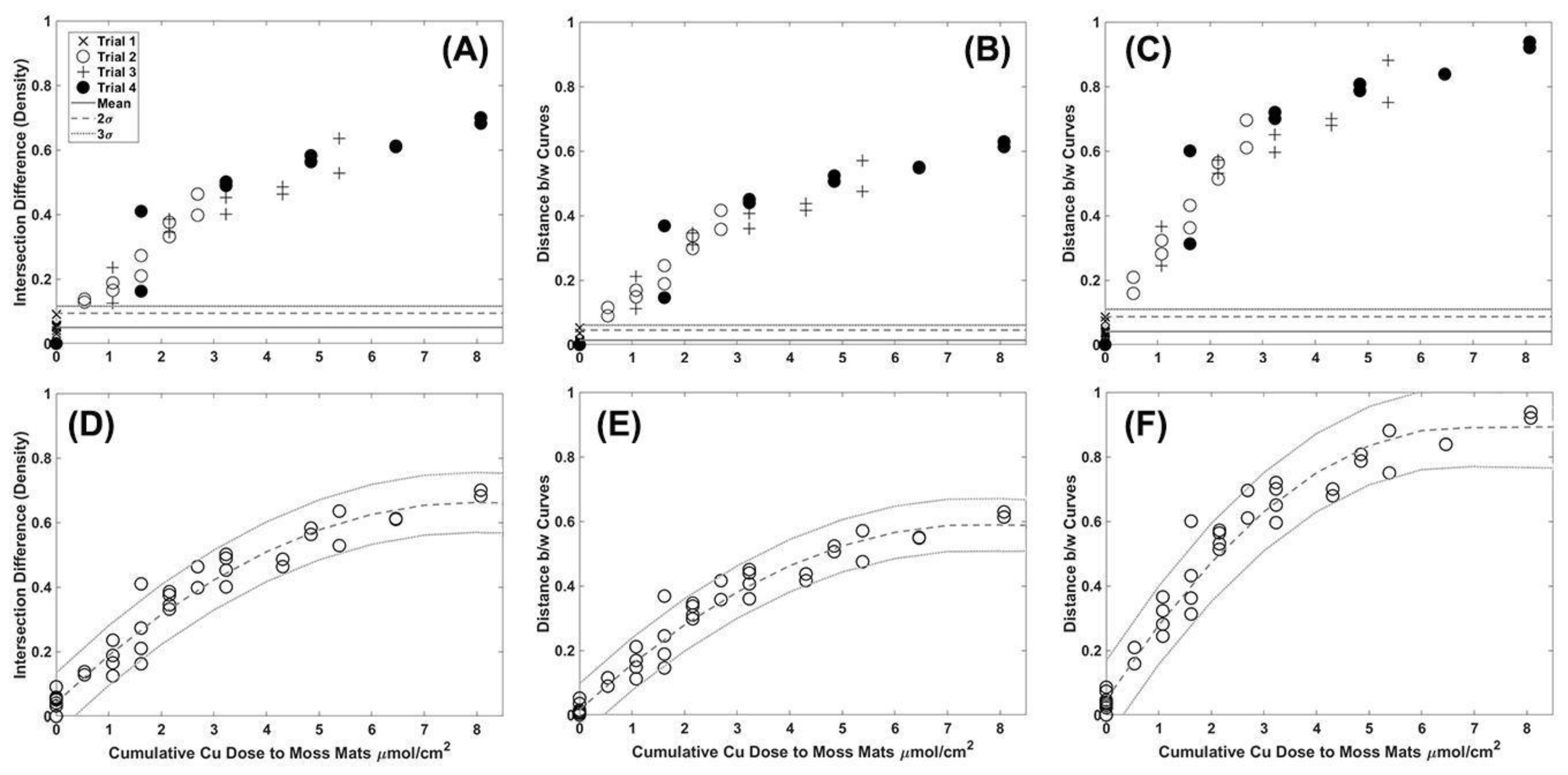Quantifying Moss Response to Metal Contaminant Exposure Using Laser-Induced Fluorescence
Abstract
:Featured Application
Abstract
1. Introduction
2. Materials and Methods
2.1. Laboratory Treatment of Moss with Copper
2.2. Laser-Induced Fluorescence Imaging
2.3. Image Analysis
3. Results
3.1. Moss Cu Content
3.2. Gain Selection
3.3. Qualitative Description of LIF Image Color Components
3.3.1. 48 h Imaging Analysis
3.3.2. 10-Day Experiment Analysis
3.4. Quantitative Analysis of LIF Image Color Components
3.4.1. Interpreting Trends
3.4.2. Single-Color Histogram Comparison
3.4.3. Two-Color Histogram Comparison
4. Discussion
5. Conclusions
Supplementary Materials
Author Contributions
Funding
Institutional Review Board Statement
Informed Consent Statement
Data Availability Statement
Conflicts of Interest
Appendix A
| Trial | 1 | 2 | 3 | 4 | 5 | 6 | 7 | 8 | 9 | 10 | Mean | |
|---|---|---|---|---|---|---|---|---|---|---|---|---|
| Red | 1 | 5.80 | 4.00 | 5.80 | 3.10 | 5.40 | 5.90 | 5.20 | 5.00 | 9.10 | 5.50 | 5.50 |
| 2 | 12.80 | 13.70 | 16.50 | 18.80 | 21.00 | 27.30 | 33.10 | 37.50 | 39.80 | 46.30 | 26.70 | |
| 3 | 12.40 | 23.50 | 34.50 | 38.60 | 40.10 | 45.20 | 46.30 | 48.60 | 52.80 | 63.50 | 40.60 | |
| 4 | 16.20 | 41.00 | 48.90 | 50.10 | 56.30 | 58.30 | 61.00 | 61.20 | 68.20 | 70.00 | 53.10 | |
| Green | 1 | 6.40 | 4.60 | 4.80 | 2.70 | 5.00 | 5.60 | 5.20 | 5.30 | 10.90 | 6.40 | 5.70 |
| 2 | 17.20 | 17.50 | 24.10 | 27.40 | 31.20 | 35.50 | 42.00 | 45.10 | 49.20 | 55.90 | 34.50 | |
| 3 | 21.60 | 29.50 | 43.40 | 45.80 | 48.20 | 50.90 | 54.20 | 55.70 | 58.80 | 68.50 | 47.70 | |
| 4 | 27.40 | 47.40 | 55.20 | 56.70 | 61.40 | 62.60 | 65.10 | 65.00 | 71.20 | 72.50 | 58.40 | |
| Blue | 1 | 5.90 | 3.60 | 4.40 | 2.90 | 4.20 | 3.70 | 5.00 | 4.40 | 8.10 | 5.60 | 4.80 |
| 2 | 13.70 | 12.60 | 19.80 | 19.80 | 24.30 | 28.10 | 33.40 | 35.20 | 42.70 | 47.50 | 27.70 | |
| 3 | 18.60 | 27.00 | 37.30 | 39.50 | 40.90 | 45.30 | 50.20 | 49.20 | 53.50 | 63.50 | 42.50 | |
| 4 | 22.70 | 42.30 | 50.00 | 50.40 | 56.30 | 56.90 | 59.70 | 60.90 | 66.60 | 67.80 | 53.40 |
| Trial | 1 | 2 | 3 | 4 | 5 | 6 | 7 | 8 | 9 | 10 | Mean | |
|---|---|---|---|---|---|---|---|---|---|---|---|---|
| Red | 1 | 0.15 | 0.60 | 5.20 | 0.52 | 0.88 | 1.02 | 0.74 | 0.73 | 3.53 | 0.65 | 1.53 |
| 2 | 11.51 | 8.93 | 14.86 | 16.86 | 18.86 | 24.43 | 29.71 | 33.71 | 35.71 | 41.57 | 23.57 | |
| 3 | 11.19 | 21.14 | 31.00 | 34.71 | 36.00 | 40.57 | 41.57 | 43.71 | 47.43 | 57.14 | 36.43 | |
| 4 | 14.57 | 36.86 | 44.00 | 45.00 | 50.57 | 52.43 | 54.86 | 55.00 | 61.29 | 63.00 | 47.71 | |
| Green | 1 | 1.53 | 1.69 | 4.31 | 0.06 | 0.63 | 0.62 | 0.48 | 0.58 | 9.76 | 0.66 | 2.09 |
| 2 | 13.71 | 11.03 | 21.57 | 24.57 | 28.00 | 32.00 | 37.71 | 40.57 | 44.14 | 50.29 | 30.43 | |
| 3 | 19.43 | 2.66 | 39.00 | 4.12 | 43.29 | 45.71 | 48.71 | 50.00 | 52.86 | 61.57 | 42.86 | |
| 4 | 24.57 | 42.57 | 49.57 | 51.00 | 55.14 | 56.29 | 58.57 | 58.43 | 64.00 | 65.14 | 52.57 | |
| Blue | 1 | 1.10 | 3.24 | 3.91 | 2.63 | 3.79 | 4.80 | 4.49 | 3.91 | 7.27 | 0.82 | 3.16 |
| 2 | 12.31 | 11.33 | 17.71 | 17.71 | 21.86 | 25.29 | 30.00 | 31.57 | 38.43 | 42.71 | 24.86 | |
| 3 | 16.71 | 24.29 | 33.57 | 35.57 | 36.86 | 40.71 | 45.14 | 44.29 | 48.00 | 57.14 | 38.14 | |
| 4 | 20.43 | 38.00 | 45.00 | 45.29 | 50.57 | 51.14 | 53.71 | 54.71 | 59.86 | 60.86 | 48.00 |
| Day | 1 | 2 | 3 | 4 | 5 | 6 | 7 | 8 | 9 | 10 |
|---|---|---|---|---|---|---|---|---|---|---|
| Trial 1 | 3.87 | 3.54 | 7.36 | 2.27 | 2.94 | 4.61 | 3.63 | 3.94 | 8.59 | 3.94 |
| Trial 2 | 20.86 | 15.86 | 28.14 | 32.29 | 36.29 | 43.14 | 51.29 | 56.43 | 61.00 | 69.57 |
| Trial 3 | 24.43 | 36.57 | 53.00 | 57.29 | 59.57 | 65.00 | 67.86 | 70.00 | 75.00 | 88.14 |
| Trial 4 | 31.29 | 60.00 | 70.00 | 72.00 | 78.71 | 80.71 | 83.86 | 83.86 | 92.00 | 93.86 |
References
- Tremper, A.H.; Agneta, M.; Burton, S.; Higgs, D.E.B. Field and Laboratory Exposures of Two Moss Species to Low Level Metal Pollution. J. Atmos. Chem. 2004, 49, 111–120. [Google Scholar] [CrossRef]
- Lazo, P.; Kika, A.; Qarri, F.; Bekteshi, L.; Allajbeu, S.; Stafilov, T. Air Quality Assessment by Moss Biomonitoring and Trace Metals Atmospheric Deposition. Aerosol Air Qual. Res. 2022, 22, 220008. [Google Scholar] [CrossRef]
- Krzesłowska, M. The cell wall in plant cell response to trace metals: Polysaccharide remodeling and its role in defense strategy. Acta Physiol. Plant. 2011, 33, 35–51. [Google Scholar] [CrossRef] [Green Version]
- Carginale, V.; Sorbo, S.; Capasso, C.; Trinchella, F.; Cafiero, G.; Basile, A. Accumulation, localisation, and toxic effects of cadmium in the liverwort Lunularia cruciata. Protoplasma 2004, 223, 53–61. [Google Scholar] [CrossRef]
- Choudhury, S.; Panda, S.K. Toxic Effects, Oxidative Stress and Ultrastructural Changes in Moss Taxithelium Nepalense (Schwaegr.) Broth. under Chromium and Lead Phytotoxicity. Water Air Soil Pollut. 2005, 167, 73–90. [Google Scholar] [CrossRef]
- Schröder, W.; Nickel, S. Moss species-specific accumulation of atmospheric deposition? Environ. Sci. Eur. 2019, 31, 78. [Google Scholar] [CrossRef] [Green Version]
- Degola, F.; De Benedictis, M.; Petraglia, A.; Massimi, A.; Fattorini, L.; Sorbo, S.; Basile, A.; di Toppi, L.S. A Cd/Fe/Zn-Responsive Phytochelatin Synthase is Constitutively Present in the Ancient Liverwort Lunularia cruciata (L.) Dumort. Plant Cell Physiol. 2014, 55, 1884–1891. [Google Scholar] [CrossRef] [Green Version]
- Zvereva, E.L.; Kozlov, M.V.; Kozlov, M. Impacts of Industrial Polluters on Bryophytes: A Meta-analysis of Observational Studies. Water Air Soil Pollut. 2010, 218, 573–586. [Google Scholar] [CrossRef]
- Koz, B.; Cevik, U. Lead adsorption capacity of some moss species used for heavy metal analysis. Ecol. Indic. 2014, 36, 491–494. [Google Scholar] [CrossRef]
- Sun, S.-Q.; He, M.; Cao, T.; Zhang, Y.-C.; Han, W. Response mechanisms of antioxidants in bryophyte (Hypnum plumaeforme) under the stress of single or combined Pb and/or Ni. Environ. Monit. Assess. 2008, 149, 291–302. [Google Scholar] [CrossRef]
- Onianwa, P.C. Monitoring Atmospheric Metal Pollution: A Review of the Use of Mosses as Indicators. Environ. Monit. Assess. 2001, 71, 13–50. [Google Scholar] [CrossRef] [PubMed]
- Boquete, M.T.; Lang, I.; Weidinger, M.; Richards, C.L.; Alonso, C. Patterns and mechanisms of heavy metal accumulation and tolerance in two terrestrial moss species with contrasting habitat specialization. Environ. Exp. Bot. 2020, 182, 104336. [Google Scholar] [CrossRef]
- Reski, R. Development, Genetics and Molecular Biology of Mosses. Bot. Acta 1998, 111, 1–15. [Google Scholar] [CrossRef]
- Berg, T.; Røyset, O.; Steinnes, E.; Vadset, M. Atmospheric trace element deposition: Principal component analysis of ICP-MS data from moss samples. Environ. Pollut. 1995, 88, 67–77. [Google Scholar] [CrossRef]
- Chaligava, O.; Shetekauri, S.; Badawy, W.M.; Frontasyeva, M.V.; Zinicovscaia, I.; Shetekauri, T.; Kvlividze, A.; Vergel, K.; Yushin, N. Characterization of Trace Elements in Atmospheric Deposition Studied by Moss Biomonitoring in Georgia. Arch. Environ. Contam. Toxicol. 2020, 80, 350–367. [Google Scholar] [CrossRef] [PubMed]
- Stanković, J.D.; Sabovljević, A.D.; Sabovljević, M.S. Bryophytes and heavy metals: A review. Acta Bot. Croat. 2018, 77, 109–118. [Google Scholar] [CrossRef]
- Shakya, K.; Chettri, M.K.; Sawidis, T. Impact of Heavy Metals (Copper, Zinc, and Lead) on the Chlorophyll Content of Some Mosses. Arch. Environ. Contam. Toxicol. 2007, 54, 412–421. [Google Scholar] [CrossRef]
- Kinsey, J.L. Laser-Induced Fluorescence. Annu. Rev. Phys. Chem. 1977, 28, 349–372. [Google Scholar] [CrossRef]
- Maarek, J.-M.I.; Kim, S. Multispectral excitation of time-resolved fluorescence of biological compounds: Variation of fluorescence lifetime with excitation and emission wavelengths. Proc. SPIE 2001, 4252, 124–131. [Google Scholar] [CrossRef]
- Zare, R.N. My Life with LIF: A Personal Account of Developing Laser-Induced Fluorescence. Annu. Rev. Anal. Chem. 2012, 5, 1–14. [Google Scholar] [CrossRef]
- García-Sánchez, F.; Galvez-Sola, L.; Nicolás, J.J.M.; Muelas-Domingo, R.; Nieves, M. Using Near-Infrared Spectroscopy in Agricultural Systems. In Developments in Near-Infrared Spectroscopy; IntechOpen: London, UK, 2017. [Google Scholar] [CrossRef] [Green Version]
- Tan, J.Y.; Ker, P.J.; Lau, K.Y.; Hannan, M.A.; Tang, S.G.H. Applications of Photonics in Agriculture Sector: A Review. Molecules 2019, 24, 2025. [Google Scholar] [CrossRef] [PubMed] [Green Version]
- Amir, M.; Chen, J.; Chen, B.; Wang, S.; Zhu, K.; Li, Y.; Meng, Z.; Ma, L.; Wang, X.; Liu, Y.; et al. Reflectance and chlorophyll fluorescence-based retrieval of photosynthetic parameters improves the estimation of subtropical forest productivity. Ecol. Indic. 2021, 131, 108133. [Google Scholar] [CrossRef]
- Chappelle, E.W.; Wood, F.M.; McMurtrey, J.E.; Newcomb, W.W. Laser-induced fluorescence of green plants 1: A technique for the remote detection of plant stress and species differentiation. Appl. Opt. 1984, 23, 134–138. [Google Scholar] [CrossRef] [PubMed]
- Na Ayudhya, T.I.; Posey, F.T.; Tyus, J.C.; Dingra, N.N. Using a Microscale Approach to Rapidly Separate and Characterize Three Photosynthetic Pigment Species from Fern. J. Chem. Educ. 2015, 92, 920–923. [Google Scholar] [CrossRef]
- Misra, A.K.; Acosta-Maeda, T.E.; Sandford, M.; Gasda, P.J.; Porter, J.N.; Sharma, S.K.; Lucey, P.; Garmire, D.; Zhou, J.; Oyama, T.; et al. Standoff Biofinder: Powerful search for life instrument for planetary exploration. In Proceedings of the Lidar Remote Sensing for Environmental Monitoring XVI, Honolulu, HI, USA, 24–25 September 2018. [Google Scholar] [CrossRef]
- Krzesłowska, M.; Rabęda, I.; Lewandowski, M.; Samardakiewicz, S.; Basinska, A.; Napieralska, A.; Mellerowicz, E.J.; Wozny, A. Pb induces plant cell wall modifications—in particular—the increase of pectins able to bind metal ions level. E3S Web Conf. 2013, 1, 26008. [Google Scholar] [CrossRef]
- Staples, G.W.; Imada, C.T.; Hoe, W.J.; Smith, C.W. A revised checklist of Hawaiian mosses. Bryophyt. Divers. Evol. 2004, 25, 36–69. [Google Scholar] [CrossRef] [Green Version]
- Hu, R.; Yan, Y.; Zhou, X.; Wang, Y.; Fang, Y. Monitoring Heavy Metal Contents with Sphagnum Junghuhnianum Moss Bags in Relation to Traffic Volume in Wuxi, China. Int. J. Environ. Res. Public Health 2018, 15, 374. [Google Scholar] [CrossRef] [Green Version]
- González, A.; Pokrovsky, O. Metal adsorption on mosses: Toward a universal adsorption model. J. Colloid Interface Sci. 2014, 415, 169–178. [Google Scholar] [CrossRef]
- Maresca, V.; Bellini, E.; Landi, S.; Capasso, G.; Cianciullo, P.; Carraturo, F.; Pirintsos, S.; Sorbo, S.; di Toppi, L.S.; Esposito, S.; et al. Biological responses to heavy metal stress in the moss Leptodictyum riparium (Hedw.) Warnst. Ecotoxicol. Environ. Saf. 2021, 229, 113078. [Google Scholar] [CrossRef]
- Ryan, G.F. Controlling Mosses and Liverworts. Breeders Roundtable in Eugene, Oregon. Western Washington Research and Extension Center. 1977. Available online: https://scholar.lib.vt.edu/ejournals/JARS/v32n2/v32n2-ryan.htm (accessed on 15 July 2020).
- Brown, D.H.; Wells, J.M. Sequential elution technique for determining the cellular location of cations. In Methods in Bryology. Proceedings of the Bryological Methods; Glime, J.M., Ed.; Hattori Botanical Laboratory: Nichinan, Japan, 1988; pp. 227–233. [Google Scholar]
- Vázquez, M.; López, J.; Carballeira, A. Modification of the sequential elution technique for the extraction of heavy metals from bryophytes. Sci. Total Environ. 1999, 241, 53–62. [Google Scholar] [CrossRef]
- Pérez-Llamazares, A.; Galbán-Malagón, C.J.; Aboal, J.R.; Fernández, J.; Carballeira, A. Evaluation of cations and chelating agents as extracellular extractants for Cu, Pb, V and Zn in the sequential elution technique applied to the terrestrial moss Pseudoscleropodium purum. Ecotoxicol. Environ. Saf. 2010, 73, 507–514. [Google Scholar] [CrossRef] [PubMed]
- Swain, M.J.; Ballard, D.H. Indexing via Color Histograms. In Active Perception and Robot Vision; Springer: Berlin/Heidelberg, Germany, 1992; pp. 261–273. [Google Scholar] [CrossRef]
- Jekel, C.F.; Venter, G.; Venter, M.P.; Stander, N.; Haftka, R.T. Similarity measures for identifying material parameters from hysteresis loops using inverse analysis. Int. J. Mater. Form. 2018, 12, 355–378. [Google Scholar] [CrossRef]
- Reinfelder, J.R.; Totten, L.A.; Eisenreich, S.J.; Aucott, M. Research Project Summary. New Jersey Atmospheric Deposition Network (April, 2005). Available online: https://www.nj.gov/dep/dsr/nutrients/NJ%20Atmospheric%20Deposition%20Network_RPS.pdf (accessed on 5 August 2021).
- Conko, K.M.; Rice, K.C.; Kennedy, M.M. Atmospheric wet deposition of trace elements to a suburban environment, Reston, Virginia, USA. Atmos. Environ. 2004, 38, 4025–4033. [Google Scholar] [CrossRef]
- Colman, J.A.; Rice, K.C.; Willoughby, T.C. Methodology and Significance of Studies of Atmospheric Deposition in Highway Runoff; Open-File Report 01-259; US Geological Survey: Northborough, MA, USA, 2001. Available online: https://pubs.usgs.gov/of/2001/ofr01-259/pdf/ofr01259.pdf (accessed on 5 August 2021).
- Pan, Y.P.; Wang, Y.S. Atmospheric wet and dry deposition of trace elements at 10 sites in Northern China. Atmos. Chem. Phys. 2015, 15, 951–972. [Google Scholar] [CrossRef] [Green Version]
- Chen, Y.; Yuan, S.; Su, Y.; Wang, L. Comparison of heavy metal accumulation capacity of some indigenous mosses in Southwest China cities: A case study in Chengdu city. Plant Soil Environ. 2010, 56, 60–66. [Google Scholar] [CrossRef] [Green Version]
- Figueira, R.; Sérgio, C.; Sousa, A. Distribution of trace metals in moss biomonitors and assessment of contamination sources in Portugal. Environ. Pollut. 2002, 118, 153–163. [Google Scholar] [CrossRef]
- Jovan, S.E.; Zuidema, C.; Derrien, M.M.; Bidwell, A.L.; Brinkley, W.; Smith, R.J.; Blahna, D.; Barnhill, R.; Gould, L.; Rodríguez, A.J.; et al. Heavy metals in moss guide environmental justice investigation: A case study using community science in Seattle, WA, USA. Ecosphere 2022, 13, e4109. [Google Scholar] [CrossRef]
- Gatziolis, D.; Jovan, S.; Donovan, G.; Amacher, M.; Monleon, V. Elemental Atmospheric Pollution Assessment via Moss-Based Measurements in Portland, Oregon; Gen. Tech. Rep. PNW-GTR-938; U.S. Department of Agriculture, Forest Service, Pacific Northwest Research Station: Portland, OR, USA, 2016. Available online: https://www.fs.usda.gov/treesearch/pubs/51076 (accessed on 5 August 2021).
- Ataabadi, M.; Najafi, P. Biomonitoring of Airborne Heavy Metal Contamination. In Air Pollution. Monitoring, Modelling, Health and Control; Mukesh Khare, M., Ed.; Intechopen: London, UK, 2012; Available online: https://www.intechopen.com/books/air-pollution-monitoring-modelling-health-and-control/biomonitoring-of-airborne-heavy-metal-contamination (accessed on 5 August 2021).
- Ćujić, M.; Dragović, S.; Sabovljević, M.; Slavković-Beškoski, L.; Kilibarda, M.; Savović, J.; Onjia, A. Use of Mosses as Biomonitors of Major, Minor and Trace Element Deposition Around the Largest Thermal Power Plant in Serbia. CLEAN–Soil Air Water 2013, 42, 5–11. [Google Scholar] [CrossRef]
- Koz, B.; Cevik, U.; Akbulut, S. Heavy metal analysis around Murgul (Artvin) copper mining area of Turkey using moss and soil. Ecol. Indic. 2012, 20, 17–23. [Google Scholar] [CrossRef]
- Wahsha, M.; Bini, C.; Fontana, S.; Wahsha, A.; Zilioli, D. Toxicity assessment of contaminated soils from a mining area in Northeast Italy by using lipid peroxidation assay. J. Geochem. Explor. 2012, 113, 112–117. [Google Scholar] [CrossRef]
- Chen, Y.-E.; Wu, N.; Zhang, Z.-W.; Yuan, M.; Yuan, S. Perspective of Monitoring Heavy Metals by Moss Visible Chlorophyll Fluorescence Parameters. Front. Plant Sci. 2019, 10, 35. [Google Scholar] [CrossRef] [PubMed]










| Individual and Cumulative Cu Dose in μmol/cm2 | ||||||||||
|---|---|---|---|---|---|---|---|---|---|---|
| Day | 1 | 2 | 3 | 4 | 5 | 6 | 7 | 8 | 9 | 10 |
| Trial 1 | 0 (0) | 0 (0) | 0 (0) | 0 (0) | 0 (0) | 0 (0) | 0 (0) | 0 (0) | 0 (0) | 0 (0) |
| Trial 2 | 0.538 (0.538) | 0 (0.538) | 0.538 (1.076) | 0 (1.076) | 0.538 (1.614) | 0 (1.614) | 0.538 (2.152) | 0 (2.152) | 0.538 (2.690) | 0 (2.690) |
| Trial 3 | 1.077 (1.077) | 0 (1.077) | 1.077 (2.154) | 0 (2.154) | 1.077 (3.231) | 0 (3.231) | 1.077 (4.308) | 0 (4.308) | 1.077 (5.385) | 0 (5.385) |
| Trial 4 | 1.615 (1.615) | 0 (1.615) | 1.615 (3.230) | 0 (3.230) | 1.615 (4.845) | 0 (4.845) | 1.615 (6.46) | 0 (6.460) | 1.615 (8.075) | 0 (8.075) |
| Frond Cu Average and Standard Deviation in Μmol/G Dry Weight | ||||||||||
|---|---|---|---|---|---|---|---|---|---|---|
| Day | 1 | 2 | 3 | 4 | 5 | 6 | 7 | 8 | 9 | 10 |
| Trial 1 | 0.24 | - | - | - | 0.32 | - | - | - | - | 0.62 |
| Trial 2 | 20.67 ± 10.4 | 24.95 | 23.98 ± 19.8 | 35.07 | 62.61 | 37.12 | 197.73 | 89.69 | 128.77 | 81.42 ± 15.5 |
| Trial 3 | 47.79 ± 12.8 | 27.36 | 76.69 ± 30.4 | 43.78 | 67.71 | 84.08 | 82.82 | 69.30 | 110.08 | 100.92 ± 39.9 |
| Trial 4 | 70.46 ± 13.5 | 61.99 | 169.78 ± 13.9 | 170.45 | 339.11 | 122.05 | 211.35 | 371.17 | 301.30 | 359.62 ± 90.9 |
Publisher’s Note: MDPI stays neutral with regard to jurisdictional claims in published maps and institutional affiliations. |
© 2022 by the authors. Licensee MDPI, Basel, Switzerland. This article is an open access article distributed under the terms and conditions of the Creative Commons Attribution (CC BY) license (https://creativecommons.org/licenses/by/4.0/).
Share and Cite
Truax, K.; Dulai, H.; Misra, A.; Kuhne, W.; Fuleky, P. Quantifying Moss Response to Metal Contaminant Exposure Using Laser-Induced Fluorescence. Appl. Sci. 2022, 12, 11580. https://doi.org/10.3390/app122211580
Truax K, Dulai H, Misra A, Kuhne W, Fuleky P. Quantifying Moss Response to Metal Contaminant Exposure Using Laser-Induced Fluorescence. Applied Sciences. 2022; 12(22):11580. https://doi.org/10.3390/app122211580
Chicago/Turabian StyleTruax, Kelly, Henrietta Dulai, Anupam Misra, Wendy Kuhne, and Peter Fuleky. 2022. "Quantifying Moss Response to Metal Contaminant Exposure Using Laser-Induced Fluorescence" Applied Sciences 12, no. 22: 11580. https://doi.org/10.3390/app122211580





